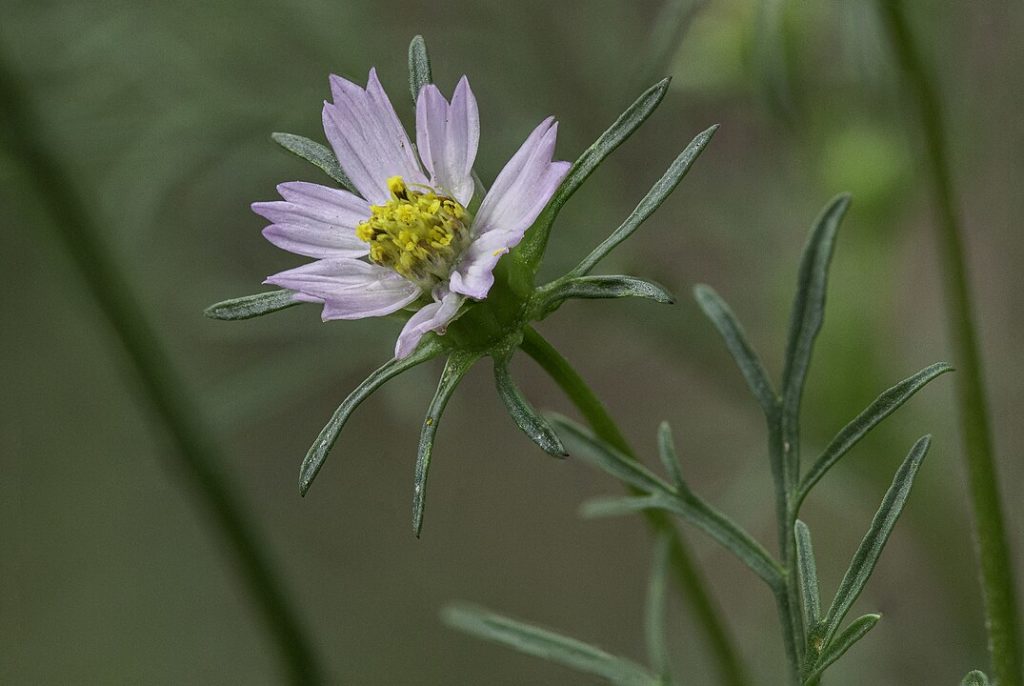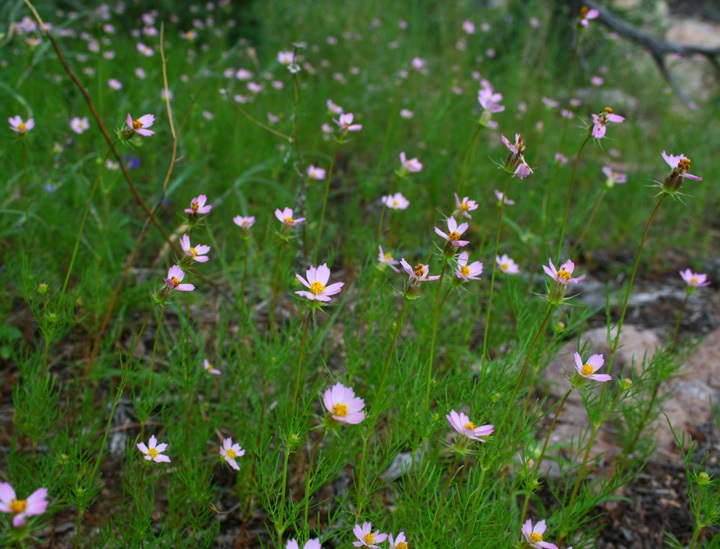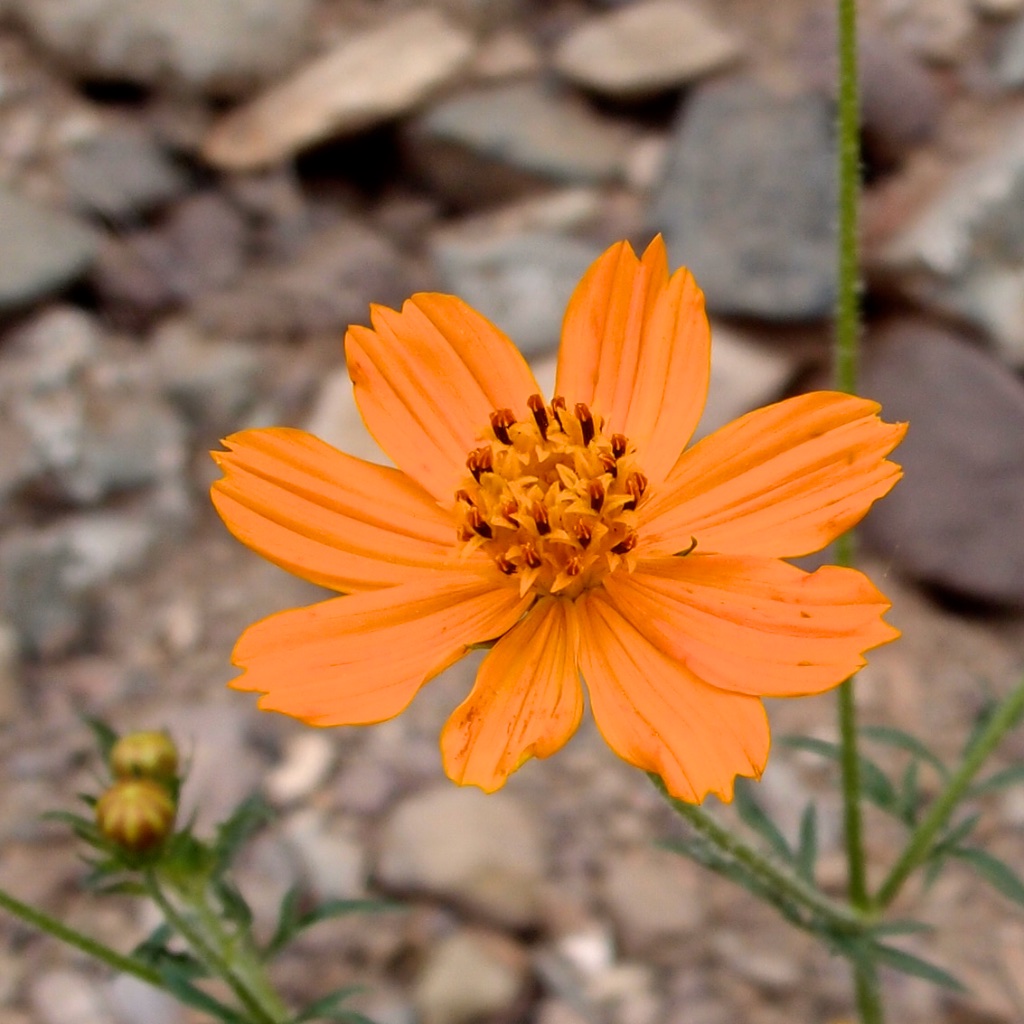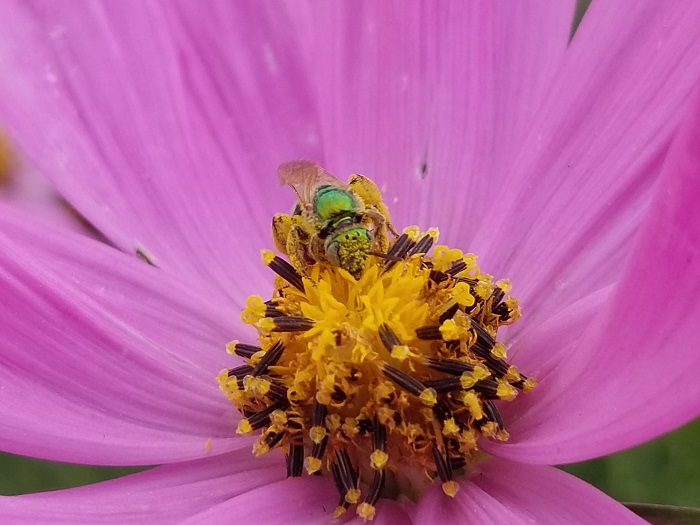Genus: Cosmos
Common name: cosmos
Family: Asteraceae
Life form: Herbaceous perennial plants or annual plants (depending on species)
Article by Peggy Rudberg
The word cosmos evokes stunning images of nebula and galaxies. Translated from the Greek kosmos as “order” or “decoration”, its sense subsequently expanded to mean the universe. The human eye is not capable of perceiving the infrared light or radio waves of space. But astrophysicists use frequency filters to capture invisible light and by combining images, construct pictures of the universe that your eyes could see if you had the same sized lenses as the Hubble telescope.
Coming back to earth, there is a colorful genus of flowers, Cosmos, that can brighten up your world closer to home. The species Cosmos parviflorus (Jacp.) Pers. or southwest cosmos, is native to New Mexico and the southwest. This species has white to pale pink to violet composite flowers common to many of the other blossoms in the more than 23,000 species in the Asteraceae family. The 1-inch flower is composed of 8 ray petals edged with 3 coarse wavy teeth and a yellow center of tubular disc flowers. The whorls of arching outer bracts under the flower are slender and tapering. Each narrow stem, up to 3 feet high, arranged with feathery opposite compound leaves, bears a single flower.

Southwestern Cosmos (Cosmos parviflorus) by Craig Martin – https://www.inaturalist.org/photos/49009149, CC0 1.0 DEED
The flowers bloom from June to October and produce barbed seeds that adhere to passersby for distribution, providing a self-sowing propagation for this annual plant. In the wild it thrives in sunny woodland and forest settings from 4000-9000 feet, sometimes finding the semi-moist, sandy or gravelly soil it prefers in disturbed areas or canyons.

Cosmos parviflorus. Photographer: Liz Makings, Manager: ASU Vascular Plant Herbarium. Locality: Peloncillo Mountains, NM. SEINet Portal Network. 2024. http//:swbiodiversity.org/seinet/index.php. Accessed on March 25.

Cosmos bipinnatus Photographer: Paul Rothrock. SEINet Portal Network. 2024. http//:swbiodiversity.org/seinet/index.php. Accessed on March 25.
New Mexico has a second cosmos species, C. bipinnatus or garden cosmos, native to Mexico but naturalized here. This annual grows taller, up to 4 feet, with larger flowers and a color range extending into red. C. sulphureus and C. atrosanguineus are additional Mexican natives available in United States nurseries that are extremely heat tolerant and their many cultivars, often dwarf, display showy orange, red and burgundy flowers.
Cosmos are easy to grow in your home garden. They prefer neutral to moderate alkaline PH soil but will tolerate poor, low nutrient soils. They will be more vigorous in full sun, and thrive in hot environments. Once established, they require little water. Deadheading (trim the stem at 45-degree angle with clean tool above the top set of healthy leaves) extends the flowering season and pruning, a more aggressive trim, can produce a second growth. Disease and insects rarely affect cosmos.

Cosmos sulphureus. Photographer: Sue Carnahan. Locality: Arroyo la Aduana, near Alamos, Sonora, Mexico. SEINet Portal Network. 2024. http//:swbiodiversity.org/seinet/index.php. Accessed on March 25.
You can start cosmos from seeds, either indoors several weeks before last frost or outdoors ¼ inch into loosened well-drained dirt after frost threat has passed. They will sprout in a week or two and flower within 2 months. Young plants are delicate so don’t plant too soon. Cosmos routinely self-seed as dead flower heads release seeds that go dormant until next spring, when sprouts emerge as the soil warms.
The nectar of C. parviflorus attracts native bees, butterflies, bats, hummingbirds and small birds and mammals. Livestock graze cosmos and Navajo use the plant as a burn dressing and as an infusion for ceremonial purposes. A useful and cheerful addition to the landscape.

Bee on cosmos. Photo by Jonah Winn-Lenetsky at Santa Fe Botanical Garden.
“Cosmos bipinnatus.” Missouri Botanical Garden. Web. 10 February 2024. Retrieved from: Web. https://www.missouribotanicalgarden.org/PlantFinder/PlantFinderDetails.aspx?taxonid=277181&isprofile=0&letter=C
“Cosmos parviflorus, Southwestern Cosmos.” Southwest Desert Flora. 06/27/2012; updated 06/28/2020. Web. 10 February 2024. Retrieved from: https://southwestdesertflora.com/WebsiteFolders/All_Species/Asteraceae/Cosmos%20parviflorus,%20Southwestern%20Cosmos.html
“Cosmos sulphureus.” Missouri Botanical Garden. Web. 10 February 2024. Retrieved from: https://www.missouribotanicalgarden.org/PlantFinder/PlantFinderDetails.aspx?taxonid=277308
Hansen, Sheridan and Dan Drost. “Cosmos in the Garden.” Utah State University Extension. May 2020. Web. 10 February 2024. Retrieved from:
https://extension.usu.edu/yardandgarden/research/cosmos-in-the-garden


